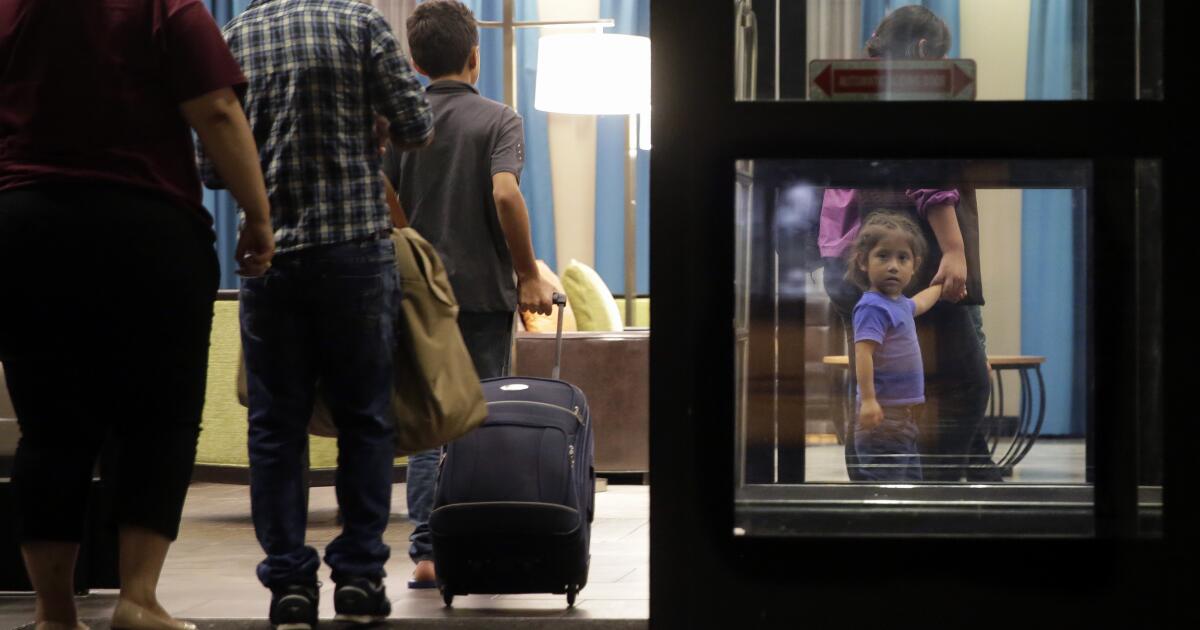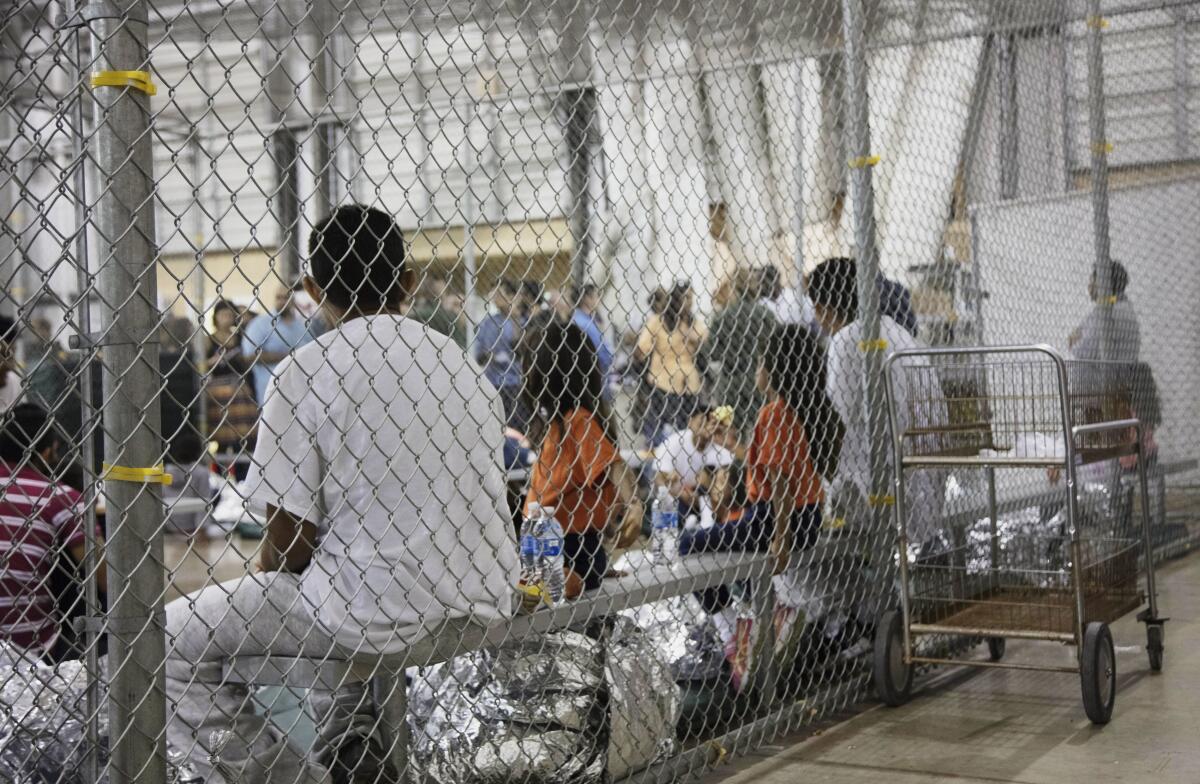
The Biden administration on Monday agreed to settle a historic Trump-era family separation lawsuit in San Diego federal court, agreeing as part of the proposed deal that the federal government will be barred for at least eight years from reenacting immigration policies that separate children and parents.
U.S. District Judge Dana Sabraw, chief federal judge in the San Diego region, must still approve the deal, which would settle a lawsuit that not only sought to reunify separated families, but pushed for reforms in border processing and highlighted one of the Trump administration’s most controversial tactics to stem illegal immigration.
The federal government and the American Civil Liberties Union, which represented thousands of separated families in the class-action lawsuit, proposed the settlement in a joint filing Monday. The agreement would also provide limited benefits such as behavioral health services and housing assistance, but not monetary damages, to families that were separated. Sabraw is expected to approve the deal later this year.
“The ACLU has settled hundreds of lawsuits in our 103-year history, but none more important than this one,” Anthony Romero, ACLU’s executive director, said in a statement. “To America’s enduring shame, we tore children from the arms of their families to enact a xenophobic agenda. This settlement closes the darkest chapter of the Trump administration, but as welcomed as it is, the damage inflicted on these families will forever be tragic and irreversible.”
Secretary of Homeland Security Alejandro Mayorkas said in a statement that the agreement “reflects the Biden-Harris administration’s unwavering commitment to reunify families who suffered because of the prior administration’s cruel and inhumane policy, and our steadfast adherence to our nation’s most dearly held values.
“This agreement helps family members reunify with their loved ones in the United States and receive services to help them address the trauma they have suffered,” he said.

FILE – In this June 17, 2018, file photo provided by U.S. Customs and Border Protection, people who’ve been taken into custody related to cases of illegal entry into the United States, sit in one of the cages at a facility in McAllen, Texas.
(ASSOCIATED PRESS)
There are essentially two parts to the settlement. One deals with the continued reunification of separated families and benefits that will be provided to them, such as work authorization, legal support for immigration claims, some housing assistance, certain medical coverage and behavioral health services. The ACLU estimates that between 4,500 and 5,000 children and their parents will be covered under the settlement.
The second part deals with the federal government’s agreement not to reenact the Trump administration’s “zero tolerance” policy, which led to family separations, for at least eight years. It still allows the government to separate families under special circumstances, such as when the child or parent presents a narrowly defined public safety or national security risk; if the parent or guardian poses a threat to the child; or if the parent is the subject of an active arrest warrant.
“Although no settlement can ever erase this tragic episode, the settlement is a critical step forward to help the thousands of families that were so brutally separated by the Trump administration,” Lee Gelernt, the ACLU’s lead attorney in the case, told the Union-Tribune. “The settlement will allow these little children to finally see their parents after years of separation and permit the families to seek permanent status in the U.S. through a special asylum process.”
Gelernt said the settlement, if approved, will be binding, meaning that if Trump or another candidate were to win the presidency next year, he or she could not appeal the settlement or otherwise challenge it, except to ask Sabraw to void or otherwise alter the agreement.
That outcome would seem unlikely, considering the judge’s previous rulings in the case. In June 2018, a few months after the lawsuit was filed, he issued an order for the government to reunify all of the children it separated, describing the issue as “a chaotic circumstance of the government’s own making.”
Sabraw later ordered the government to create a system to document and track all future separations across various federal agencies so that reunifications could happen as soon as legally possible. Such a system was not in place when the Trump administration first began separating thousands of families, leading to an inability to easily track either the children or the parents.
The initial search and reunification effort was aimed at children who had been separated and were in the government’s care as of late June 2018, shortly after the Trump administration’s “zero tolerance” policy had been widely rolled out across the southwestern border. The “zero tolerence” program put adults caught crossing into the U.S. illegally into criminal custody for misdemeanor prosecution and separated them from any accompanying children, who were placed into federal shelters.
The children and adults then proceeded through the U.S. immigration system on separate tracks, with no clear way to reunite the families or keep their cases together once the adults were out of criminal custody. Many parents had no idea where their children were. Hundreds of parents were deported without their children.
Some families who presented themselves at ports of entry to claim asylum were also separated.
The effort undertaken after Sabraw’s initial order for the government to help track down all separated parents took about six months, with more than 2,000 families reunited. The effort was made easier because most of the parents were still in U.S. immigration custody.
It didn’t become public until later that the family separation program had actually begun about a year earlier, in the summer of 2017, as a pilot program in Texas. An updated accounting found an additional 1,500-plus children who had been separated, leading to a much more difficult search effort, since the passage of time meant many parents were out of custody — and out of the country.
Over the past several years, a committee of pro-bono attorneys working with nonprofit groups have labored to track down parents of more than 1,000 children — cold-calling phone numbers off of government rosters, advertising a hotline number through international media and in many cases trekking through Central American villages. As of August, the parents of 75 children had not yet been located, according to a recent court filing.
Even after the official policy was ended, some family separations still occurred under both the Trump and Biden administrations, according to immigrant advocacy groups and media reports. The settlement proposed Monday includes special circumstances in which the government can still separate families, and only pertains to families detained at the border and not those detained in the interior of the country.
The settlement announced Monday is the result of negotiations that began in March 2021, shortly after Biden took office and a month after the creation of a Family Reunification Task Force.
In his statement, Mayorkas thanked the Department of Justice and Department of Health and Human Services in helping to reach a deal.
“We also recognize the important work of non-governmental organizations that have stood by the families and continue to support their reunification,” Mayorkas said. “Our partnership is unified in condemning the cruelty of the past.”
The settlement is expected to go before Sabraw for final approval in December. Before that time, anyone can file an objection, including those who are not party to the lawsuit, Gelernt, the ACLU attorney, said. The judge must also weigh those objections before deciding whether to approve the agreement.






